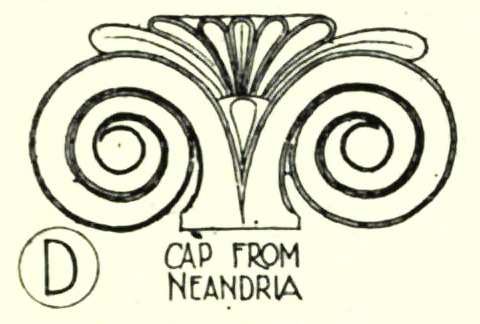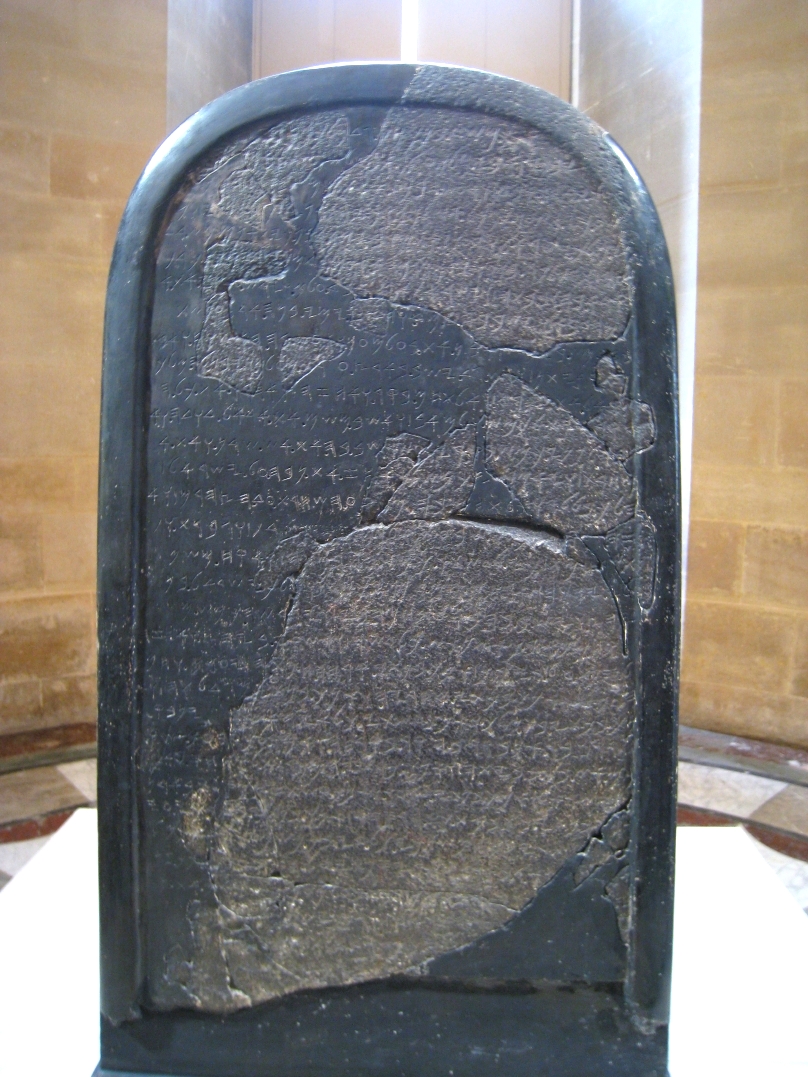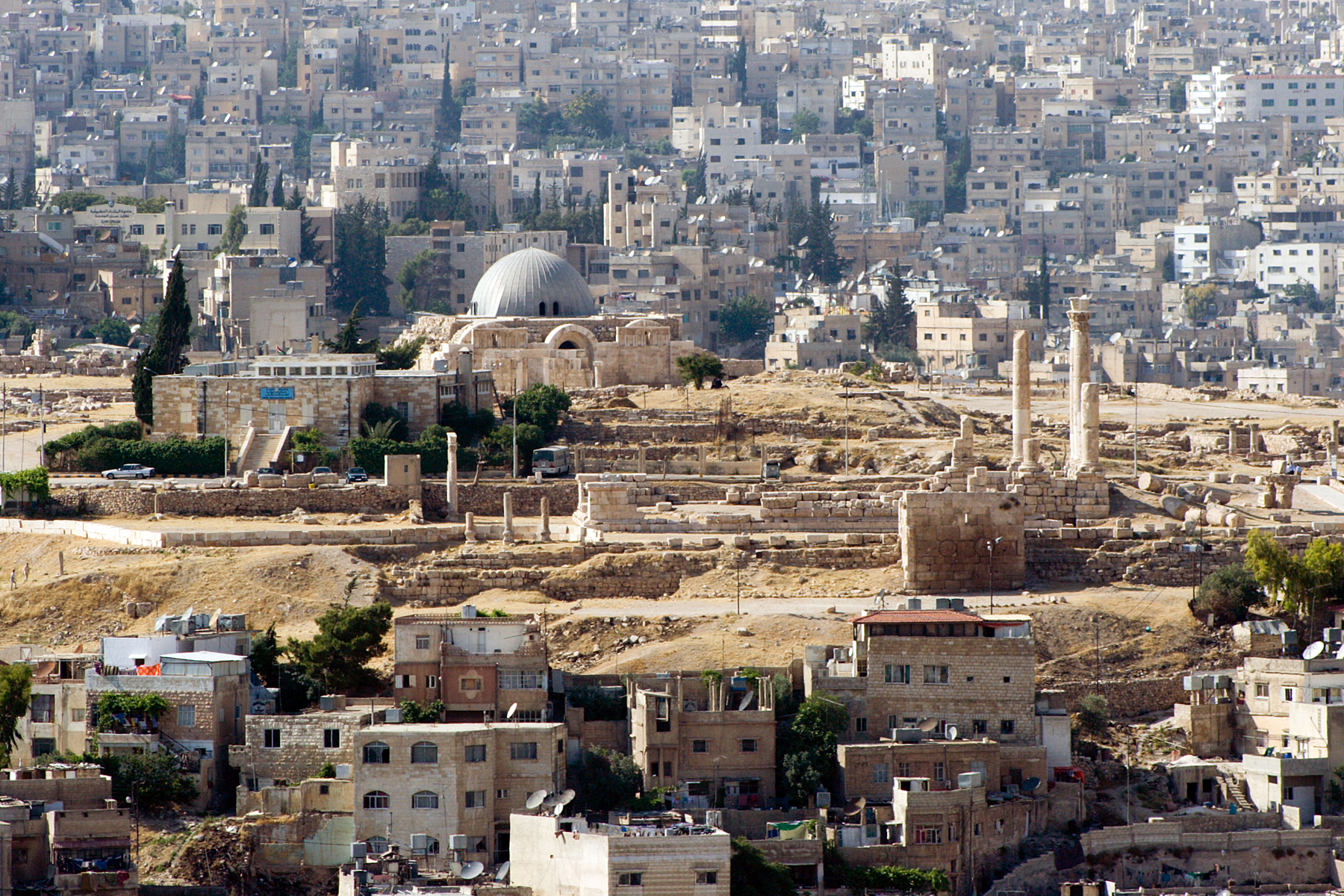|
Aeolic Order
The Aeolic order or Aeolian order was an early order of Classical architecture. It has a strong similarity to the better known Ionic order, but differs in the capital, where a palmette rises between the two outer volutes, rather than them being linked horizontally by a form at the top of the capital. Many examples also show simplified details compared to the Ionic. "Proto-Aeolic" capitals of Southern Levant Decorated stone structures reminiscent of the Aeolic order, widely known as "Proto-Aeolic" or "Proto-Ionian" capitals, were especially common in the Southern Levant during the Iron Age. Capitals of this style were discovered in royal buildings and fortified city gates. They were built up for some ashlar masonries, an architectonic style reserved to Israelite royal structures. One of them is 110 x 28 x 60 cm of dimension and also differs from the canon for its ornamental details, showing a triangular shape in the center as the point of juncture of the capital volutes. Pr ... [...More Info...] [...Related Items...] OR: [Wikipedia] [Google] [Baidu] |
Aeolic Capital From Neandria
In linguistics, Aeolic Greek (), also known as Aeolian (), Lesbian or Lesbic dialect, is the set of dialects of Ancient Greek spoken mainly in Boeotia; in Thessaly; in the Aegean island of Lesbos; and in the Greek colonies of Aeolis in Anatolia and adjoining islands. The Aeolic dialect shows many archaisms in comparison to the other Ancient Greek dialects ( Arcadocypriot, Attic, Ionic, and Doric varieties), as well as many innovations. Aeolic Greek is widely known as the language of Sappho and of Alcaeus of Mytilene. Aeolic poetry, which is exemplified in the works of Sappho, mostly uses four classical meters known as the Aeolics: Glyconic (the most basic form of Aeolic line), hendecasyllabic verse, Sapphic stanza, and Alcaic stanza (the latter two are respectively named for Sappho and Alcaeus). In Plato's ''Protagoras'', Prodicus labelled the Aeolic dialect of Pittacus of Mytilene as "barbarian" (''barbaros''), because of its difference from the Attic literary style: "He d ... [...More Info...] [...Related Items...] OR: [Wikipedia] [Google] [Baidu] |
Dan (ancient City)
Dan ( he, דן) is an ancient city mentioned in the Hebrew Bible, described as the northernmost city of the Kingdom of Israel, and belonging to the tribe of Dan. The city is identified with a tell located in Upper Galilee, northern Israel, known as Tel Dan (; "Mound of Dan") in Hebrew. Identification and names The Hebrew Bible states that prior to its conquest by the tribe of Dan the site was known as Laish with variant spellings within the Books of Joshua, Judges and Isaiah. In it is called Leshem, which means "jewel". has the alternative name ''Laishah'' in a number of translations. Rabbinic works, and writers like Philostorgius, Theodoret, Benjamin of Tudela and Samuel ben Samson, all incorrectly identified Dan or Laish, with Banias (Paneas).Saulcy, 1854, pp537538 Eusebius of Caesarea more accurately places Dan/Laish in the vicinity of Paneas at the fourth mile on the route to Tyre. 19th century Swiss traveler Johann Ludwig Burckhardt identified the source of the Jordan ... [...More Info...] [...Related Items...] OR: [Wikipedia] [Google] [Baidu] |
Ancient Near East
The ancient Near East was the home of early civilizations within a region roughly corresponding to the modern Middle East: Mesopotamia (modern Iraq, southeast Turkey, southwest Iran and northeastern Syria), ancient Egypt, ancient Iran ( Elam, Media, Parthia and Persis), Anatolia/Asia Minor and the Armenian highlands (Turkey's Eastern Anatolia Region, Armenia, northwestern Iran, southern Georgia, and western Azerbaijan), the Levant (modern Syria, Lebanon, Israel, Palestine, and Jordan), Cyprus and the Arabian Peninsula. The ancient Near East is studied in the fields of Ancient Near East studies, Near Eastern archaeology and ancient history. The history of the ancient Near East begins with the rise of Sumer in the 4th millennium BC, though the date it ends varies. The term covers the Bronze Age and the Iron Age in the region, until either the conquest by the Achaemenid Empire in the 6th century BC, that by the Macedonian Empire in the 4th century BC, or the Muslim conquest ... [...More Info...] [...Related Items...] OR: [Wikipedia] [Google] [Baidu] |
Omri
Omri ( ; he, , ''‘Omrī''; akk, 𒄷𒌝𒊑𒄿 ''Ḫûmrî'' 'ḫu-um-ri-i'' fl. 9th century BC) was, according to the Hebrew Bible, the sixth king of Israel. He was a successful military campaigner who extended the northern kingdom of Israel. Other monarchs from the House of Omri are Ahab, Ahaziah, Joram, and Athaliah. Like his predecessor, king Zimri, who ruled for only seven days, Omri is the second king mentioned in the Bible without a statement of his tribal origin. One possibility, though unproven, is that he was of the tribe of Issachar. Nothing is said in Scripture about the lineage of Omri. His name may be Amorite, Arabic, or Hebrew in origin.Thiel, W., "Omri", ''The Anchor Bible Dictionary'', p. 17, vol. 5, D.N. Freedman (ed.). New York: Doubleday (1992) Omri is credited with the construction of Samaria and establishing it as his capital. Although the Bible is silent about other actions taken during his reign, he is described as doing more evil than all the ... [...More Info...] [...Related Items...] OR: [Wikipedia] [Google] [Baidu] |
Ammon
Ammon (Ammonite: 𐤏𐤌𐤍 ''ʻAmān''; he, עַמּוֹן ''ʻAmmōn''; ar, عمّون, ʻAmmūn) was an ancient Semitic-speaking nation occupying the east of the Jordan River, between the torrent valleys of Arnon and Jabbok, in present-day Jordan. The chief city of the country was ''Rabbah'' or ''Rabbat Ammon'', site of the modern city of Amman, Jordan's capital. Milcom and Molech are named in the Hebrew Bible as the gods of Ammon. The people of this kingdom are called "Children of Ammon" or "Ammonites". History The Ammonites occupied the northern Central Trans-Jordanian Plateau from the latter part of the second millennium BCE to at least the second century CE. Ammon maintained its independence from the Neo-Assyrian Empire (10th to 7th centuries BCE) by paying tribute to the Assyrian kings at a time when that Empire raided or conquered nearby kingdoms. The Kurkh Monolith lists the Ammonite king Baasha ben Ruhubi's army as fighting alongside Ahab of Israel and ... [...More Info...] [...Related Items...] OR: [Wikipedia] [Google] [Baidu] |
Amman
Amman (; ar, عَمَّان, ' ; Ammonite language, Ammonite: 𐤓𐤁𐤕 𐤏𐤌𐤍 ''Rabat ʻAmān'') is the capital and largest city of Jordan, and the country's economic, political, and cultural center. With a population of 4,061,150 as of 2021, Amman is Jordan's primate city and is the List of largest cities in the Levant region by population, largest city in the Levant region, the list of largest cities in the Arab world, fifth-largest city in the Arab world, and the list of largest metropolitan areas of the Middle East, ninth largest metropolitan area in the Middle East. The earliest evidence of settlement in Amman dates to the 8th millennium BC, in a Neolithic site known as ʿAin Ghazal, 'Ain Ghazal, where the world's ʿAin Ghazal statues, oldest statues of the human form have been unearthed. During the Iron Age, the city was known as Rabat Aman and served as the capital of the Ammon, Ammonite Kingdom. In the 3rd century BC, Ptolemy II Philadelphus, Pharaoh of Ptole ... [...More Info...] [...Related Items...] OR: [Wikipedia] [Google] [Baidu] |
Amman Citadel
The Amman Citadel ( ar, جبل القلعة, Jabal Al-Qal'a) is an Archaeological site, archeological site at the center of downtown Amman, the capital of Jordan. The L-shaped hill is one of the seven hills (''jabals'') that originally made up Amman. The Citadel has a long history of occupation by many great civilizations.Najjar, M. "Amman Citadel Temple of Hercules Excavations Preliminary Report." ''Syria'' 70 (1993). pp. 220-225. Evidence of inhabitance since the Neolithic, Neolithic period has been found and the hill was fortified during the Bronze Age (1800 BCE). The hill became the capital of the Kingdom of Ammon sometime after 1200 BCE. It later came under the sway of empires such as the Neo-Assyrian Empire (8th century BCE), Neo-Babylonian Empire (6th century BC), the Ptolemies, the Seleucids (3rd century BCE), Roman Empire, Romans (1st century BCE), Byzantine Empire, Byzantines (3rd century CE) and the Umayyad Caliphate, Umayyads (7th century CE). After the Umayyads, ... [...More Info...] [...Related Items...] OR: [Wikipedia] [Google] [Baidu] |
Moab
Moab ''Mōáb''; Assyrian: 𒈬𒀪𒁀𒀀𒀀 ''Mu'abâ'', 𒈠𒀪𒁀𒀀𒀀 ''Ma'bâ'', 𒈠𒀪𒀊 ''Ma'ab''; Egyptian: 𓈗𓇋𓃀𓅱𓈉 ''Mū'ībū'', name=, group= () is the name of an ancient Levantine kingdom whose territory is today located in the modern state of Jordan. The land is mountainous and lies alongside much of the eastern shore of the Dead Sea. The existence of the Kingdom of Moab is attested to by numerous archaeological findings, most notably the Mesha Stele, which describes the Moabite victory over an unnamed son of King Omri of Israel, an episode also noted in 2 Kings . The Moabite capital was Dibon. According to the Hebrew Bible, Moab was often in conflict with its Israelite neighbours to the west. Etymology The etymology of the word Moab is uncertain. The earliest gloss is found in the Koine Greek Septuagint () which explains the name, in obvious allusion to the account of Moab's parentage, as ἐκ τοῦ πατρός μου ("from my ... [...More Info...] [...Related Items...] OR: [Wikipedia] [Google] [Baidu] |
Jordan
Jordan ( ar, الأردن; tr. ' ), officially the Hashemite Kingdom of Jordan,; tr. ' is a country in Western Asia. It is situated at the crossroads of Asia, Africa, and Europe, within the Levant region, on the East Bank of the Jordan River. Jordan is bordered by Saudi Arabia to the south and east, Iraq to the northeast, Syria to the north, and the Palestinian West Bank, Israel, and the Dead Sea to the west. It has a coastline in its southwest on the Gulf of Aqaba's Red Sea, which separates Jordan from Egypt. Amman is Jordan's capital and largest city, as well as its economic, political, and cultural centre. Modern-day Jordan has been inhabited by humans since the Paleolithic period. Three stable kingdoms emerged there at the end of the Bronze Age: Ammon, Moab and Edom. In the third century BC, the Arab Nabataeans established their Kingdom with Petra as the capital. Later rulers of the Transjordan region include the Assyrian, Babylonian, Roman, Byzantine, Rashidun ... [...More Info...] [...Related Items...] OR: [Wikipedia] [Google] [Baidu] |
Al-Walaja
Al-Walaja ( ar, الولجة) is a Palestinian village in the West Bank, four kilometers northwest of Bethlehem. It is an enclave in the Seam Zone, near the Green Line. Al-Walaja is partly under the jurisdiction of the Bethlehem Governorate and partly of the Jerusalem Municipality. According to the Palestinian Central Bureau of Statistics, the village had a population of 2,041 in 2007, mostly Muslims. It has been called 'the most beautiful village in Palestine'. Al-Walaja was depopulated during the 1948 Arab-Israeli War, in October 1948. It lost about 70% of its land, west of the Green Line. After the war, the displaced inhabitants resettled on the remaining land in the West Bank. After its capture during the Six-Day War, Israel annexed about half of al-Walaja's remaining land, including the neighborhood Ain Jawaizeh, to the Jerusalem Municipality. Large parts of the land were confiscated for the construction of the Israeli West Bank barrier and the Israeli settlements of Har ... [...More Info...] [...Related Items...] OR: [Wikipedia] [Google] [Baidu] |
Ramat Rachel
Ramat Rachel or Ramat Raḥel ( he, רָמַת רָחֵל, ''lit.'' Rachel's Heights) is a kibbutz located in central Israel. An enclave within Jerusalem's municipal boundaries and overlooking Bethlehem and Rachel's Tomb (for which the kibbutz is named), it falls under the jurisdiction of Mateh Yehuda Regional Council. In , it had a population of . According to archaeologists, Ramat Rachel "replaced Jerusalem as the economic and political hub of the southern highlands" in ancient times. History The kibbutz was established in 1926 by members of the Gdud HaAvoda labor brigade. Their goal was to settle in Jerusalem and earn their livelihood from manual labor, working in such trades as stonecutting, housing construction and haulage. After living in a temporary camp in Jerusalem, a group of ten pioneers settled on a stony plot of land on an 803-metre high hill south of the city. The kibbutz was destroyed by the Arabs in the riots of 1929. Hundreds of Arabs attacked the training farm ... [...More Info...] [...Related Items...] OR: [Wikipedia] [Google] [Baidu] |
City Of David (historic)
The City of David ( he, עיר דוד, translit=Īr Davīd) is the name given to an archaeological site considered by most scholars to be the original settlement core of Jerusalem during the Bronze and Iron Ages. "The prevailing view among researchers that the early city, the City of David, lay in the southern part of the eastern ridge next to the spring." It is situated on southern part of the eastern ridge of ancient Jerusalem, west of the Kidron Valley and east of the Tyropoeon valley, to the immediate south of the Temple Mount. The City of David is an important site of biblical archeology. Remains of a defensive network dating back to the Middle Bronze Age were found around the Gihon Spring; they continued to remain in use throughout subsequent periods. Two monumental Iron Age structures, known as the Large Stone Structure and the Stepped Stone Structure, were discovered at the site. Scholars debate if these may be identified with David or date to a later period. The site i ... [...More Info...] [...Related Items...] OR: [Wikipedia] [Google] [Baidu] |










